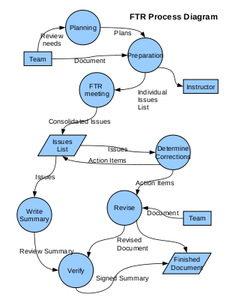Formal Technical Reviews

Remember, FTR's have been demonstrated to be the #1 method for
improving
product quality.
Inspections are internal reviews, FTR's are external reviews.
For CPE 308 FTR's, the reviewers will be another project team.
FTR's
must be scheduled at least a week in advance!
Be prepared: Read the resources, assign
roles, know your
job.
Before the FTR:
- Ask for what you want. A written form is helpful, in which
you
prioritize
your needs, make specific requests from your reviewers about how you
want
them to read your materials and the kind of critique you want.
- Limit the scope of materials to be reviewed. Be clear about the
quality,
content, and focus of the feedback you would like to receive.
Indicate
whether you want them to write a list of issues, put comments on the
document,
or whatever.
- Don't demand more than 2 hours of preparation time from your
reviewers.
- Arrange delivery of the work product in advance so reviewers have
adequate
time to prepare.
- Reviewers: Spend no more than 2 hours individually
critiquing the work product. Usually you will be asked to create
an issues list,
referring to the relevant QA criteria.
During the FTR:
- Moderator, usually QA leader, is responsible for running the
meeting
and
orchestrating how the issues are to be presented.
- Reviewers raise issues based on their advance preparation.
- Get the big problem issues on the table early. Don't get
lost in
minutely small clerical details.
- Identify problems, don't solve them.
- Focus on material, not the producer
- Elicit questions, don't answer them.
- Don't explain how your product works. An FTR is not a
product
demo.
- Watch the clock and keep momentum to get through all the issues
in the
alotted time.
- Recorder actively records all issues raised.
At the end of the FTR:
Reviewers must make a decision:
- Accept - the product is acceptable as is.
- Rework - accept the product provisionally, minor erors have been
encountered
and must be corrected, but no additional review will be required.
- Reject - the product has severe errors. You need to overhaul the
item
and
schedule another FTR.
After the FTR:
- Write up the issues list.
- Examine the issues raised, determine which to
take
action
on.
- Assign each issue to someone as an action item
and
revise
work product as needed.
- Write review summary report:
- what was reviewed
and when
- who were the
participants
and
roles
- what were the
findings and
conclusions
(especially Accept/Reject decision)
- the issues list, and
include
"action taken" for each issue raised.
- Have reviewers sign off on summary report,
indicating
proper corrective action has been taken for each issue.
- Include signed report in deliverable.
Review Guidelines
- Review the product, not the producer.
- Keep on track, don't drift.
- Limit debate and rebuttal.
- Enunciate problem areas, but don't attempt to solve the problems.
- Take written notes.
- Insist upon advance preparation. If your reviewers aren't
prepared,
cancel the meeting and reschedule.
- Consider developing a checklist for the product being reviewed.
Sample Schedule
Day 1 Complete internal review of SRS.
Handoff to reviewing team.
Accept documents from team being reviewed.
Day 2 (out of class) Review other team's SRS, create issues list.
Day 3 (during lab) FTR meeting, consolidate issues.
Participate as reviewer in other team FTR meeting.
Submit issues list to other team and instructor.
Day 4 (out of class)
Revise SRS.
Create FTR Summary Report.
Return FTR Summary Report to reviewers for verification.
Verify FTR summary report for other team.
Show SRS to customer and get signoff.
Day 5 (during lab) Receive signed FTR Summary Report from reviewers.
Day 5 (during lab) Notify instructor deliverable is ready.
Submit signed documents to instructor.
Resources
Review Issues Form
Powerpoint presentation on FTR
principles and concepts
NASA's Formal
Review Guidebook
Lethbridge section 10.10 Inspections
